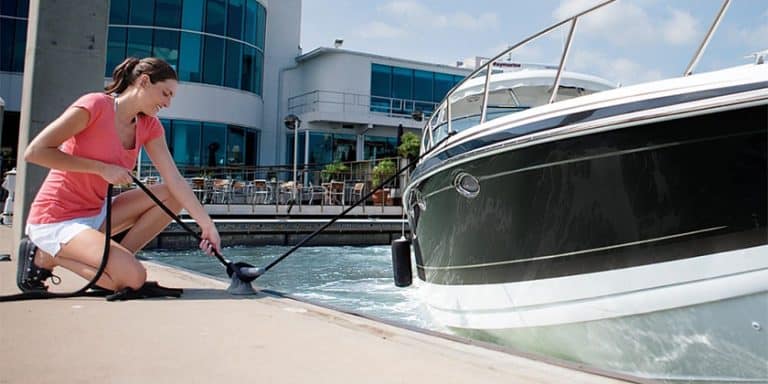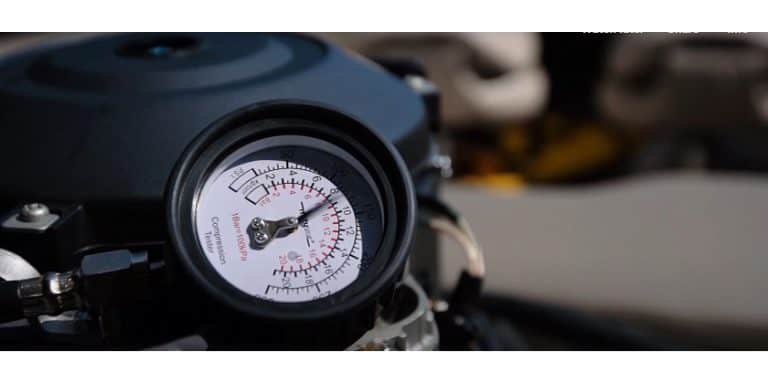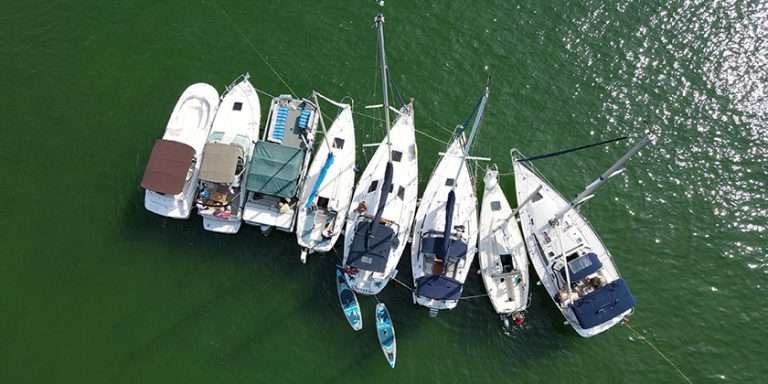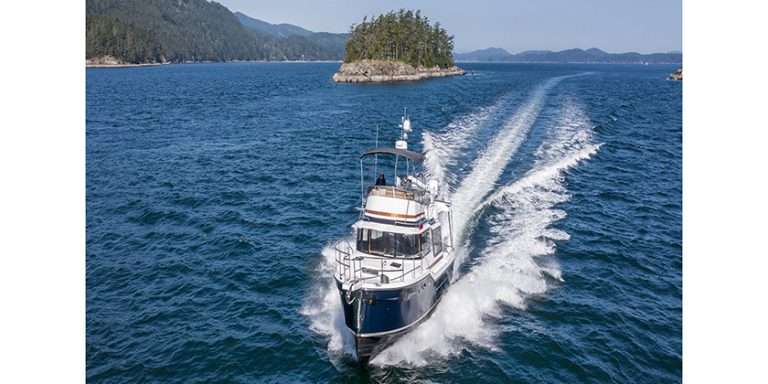How to Aim Your Boat
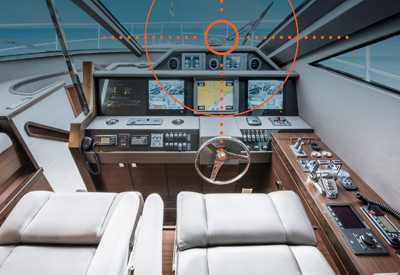
By Brenda and Doug Dawson
How often have you seen boats weaving their way across the water, unable to keep heading in a straight line? Maybe you have even experienced this snaking yourself.
Sometimes, it is because the Captain is over-steering—first too far one way, then too far the other way. It is primarily because he or she doesn’t know how to aim his or her boat.
When cruising, it is very important to know where ‘top dead centre’ is so that you can steer straight. It reduces the back and forth of the wheel and over steering. (See Canadian Yachting April 2017 for the “Top Dead Centre” article by the Dawsons – Ed).
Simply locating ‘top dead centre’on your wheel to steer straight is not the whole solution. You also need to know how to aim your boat so that it follows a straight line to a destination point—near or far.
This is obviously a problem for many boaters as you see it every day on the water. Boating forums are filled with discussions between boaters offering bad advice like:
• Get your steering checked. It is a mechanical problem.
• This is what I do, so you should try it.
• It’s prop walk, so you can’t do anything about it.
• V-hulls just do that. Get used to it.
• You’ll get better with practice.
Just because your plumber has teeth, doesn’t qualify him as a dentist.
Likewise, just because a forum boater has a boat, it doesn’t qualify him as a boat-handling instructor.
I couldn’t find one piece of correct advice that would help a boater steer his or her boat straight. In my experience, I have found that in most cases, boaters just don’t know how to aim their boat. They just wander up the lake leaving a telltale snake’s trail behind them.

To aim your boat and kill the snake…..
How Professional Captains aim the boat
Think of a rifle that you aim by lining up the near sight and the far sight with the target.Now think of your boat as the rifle. You have to know where the near and far sights are before you can aim your boat at a buoy or landmark or even dock it.
Sailors have a huge advantage because the helm is centre of the boat, so they can line up their mast and pulpit with their target. Most powerboat helms are on the starboard side, so power boaters have to calculate their sights.
For your near sight spot, pick something right in front of you on the helm or windshield; for instance, your compass or the corner of the depth sounder or a windshield wiper spot.
For your far sight spot, pick a location on the bow rail that is directly ahead of the helm between your near sight and the landmark on shore that you are headed for.
To locate your ‘far sight’ at just the right spot on your bow rail, do the following:
• Take the boat out on a perfectly calm day—no wind, no current.
• Set the throttle(s) in forward at say 800 rpm.
• Have your First Mate or one of your crew sit on the forward deck on the centreline facing the starboard side of the boat.
• Straighten the wheel to where you think you are going straight, and aim for your target on shore.
• After about 30 seconds of idling this direction, look over the transom at your wake. Is it straight or is it curved?
• Adjust the wheel to straighten it.
• Once your trail is perfectly straight and you are aimed at your target on shore, have your foredeck person reach out and touch the bow rail to locate that ‘far sight spot’ on the bow rail.
• Remember where this spot is on the bow rail.
• Now test to confirm that it is your far sight spot.
• Line up your near sight, your far sight, and your target and steer straight toward it.
• After 30 seconds or so, check your wake to verify that it is straight. If it is, you have the right location for your ‘far sight spot.’ If it isn’t straight, adjust as necessary.
• Wrap that ‘far sight spot’ with a piece of black electrical tape.
• Then you, or anyone who takes the wheel for you, can line up the sights with the target—First Mate, kids, grandkids…just line up the near and far sight with the target on shore.
 There should be a perfectly straight line between you, through the near sight spot, through the far sight spot and your target.
There should be a perfectly straight line between you, through the near sight spot, through the far sight spot and your target.
There are some fighter jets that have a long spear-shaped nose. One of the purposes for this is to give the pilot a ‘far sight spot.’
Watch for the big smiles on your grandkids faces when you compliment them saying “Turn around and look at the wake. It is straight.That means you are driving the boat perfectly straight. Well done”.This telltale sign of watching the wake was what my grandfather, Frank Dawson, taught me when I was only three years old, just learning to steer back in 1947.
I never forgot it and have shared it ever since.
Why Aiming is important
Over a long distance on one leg of your trip, using the wrong ‘far sight spot’ could put you on the rocks en route to that distant buoy.
Over a short distance like docking, a little is very significant. Using the wrong ‘far sight spot’ could cause you to scrape down the side of your slip neighbor’s boat or your dock.
If you don’t use the right location for your bow rail far sight spot, you cruise up the lake headed the wrong direction and have to keep correcting. Since the shortest distance between two points is straight line, you are wasting time and fuel when you zig-zag from point A to point B. In open water, you have space to do that, whereas in the harbour, fairway or slip, you need to be accurate.
Some boaters line up their anchor windlass or pulpit with the object they are aiming for, but both those points are on the centreline of the boat, whereas the wheel is off to starboard, so the boat isn’t headed to the target, requiring continual correcting as you get closer to your target.
The only time you would line up the anchor davit or pulpit is if your wheel is in the centre of the boat like a Centre Console, an older yacht, or a sailboat with the wheel on the centreline. When your wheel is on the centreline, more importantly, so are you and your eyes.
Technical Stuff
Some will tell you that you need to understand the “technical stuff” like the torque of the propeller or “prop walk” and how it influences your boat. The truth is, you don’t need to know any of this technical or mechanical “stuff,” you just need to know how your boat responds to the wheel, shift(s), and throttle(s) as we teach in our lessons. Torque and Prop Walk and all the other technical jargon are compensated for just like in a computer program.
You don’t have to know or understand code to use a computer program. You just need to follow the instructions and learn which key you need to press to ‘save,’‘print,’ etc. The program code looks after it all.
When you want to stop your car, you don’t have to know how the ABS brakes work, you just have to know that when you stomp on the pedal, the car will stop straight.
To handle and dock your boat, you don’t need to know the “technical stuff,” you just need to know how your boat responds to the wheel, shift(s), and throttle(s) to do exactly what you want it to do.
It’s results that count, and the easier and less complicated, the better.
How do I do it?
I line up my ‘near sight spot’ with my ‘far sight spot’ on my bow rail with whatever I am headed for, whether it is a landmark on open water, the cleat at the end of the dock, the inside end of the dock, or the space at the end of the slip.
When turning from the fairway into my slip, I turn the wheel with my left hand, so the ‘far sight spot’ on the bow rail lines up with my new target in the slip.
When the boat has completed the turn and I want to go straight again, I palm the wheel with my left hand back to the top (electrical tape spot) to recover from the turn. Then I know the wheel is straight or ‘top dead centre’ and the boat is going to go straight. I confirm by checking that my ‘far sight spot’ is on the target within the slip.
Complicated?
This may sound complicated and like a lot of work, but you only have to do it once. After that, it is just a matter of using that tape on the bow rail to line up with your target, either on the water or in the confines of the harbour or slip. It will become second nature with practice and simplify your docking.


